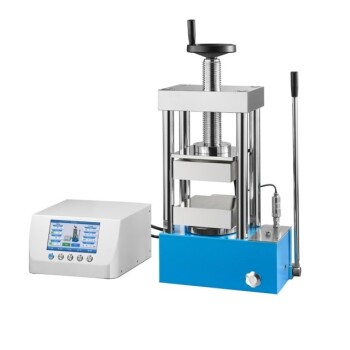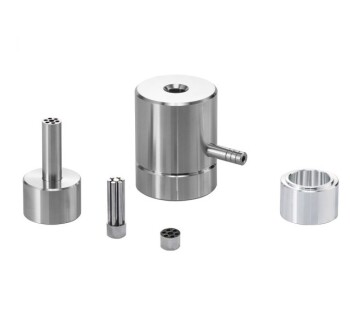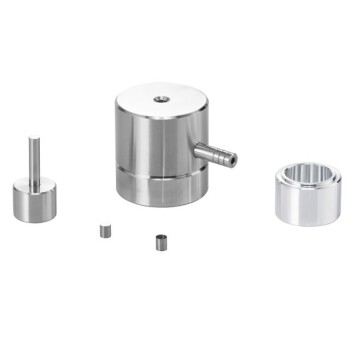At its core, a hydraulic piston is operated by a pump that pressurizes a confined hydraulic fluid. This pressurized fluid then exerts force against the face of the piston, causing it to move and perform work. The specific method of operation—whether manual, pneumatic, or electric—simply refers to the type of pump used to generate this initial pressure.
The true genius of a hydraulic press is not just moving a piston, but multiplying force. It uses an incompressible fluid to convert a small input force on a small piston into a massive output force on a larger piston, a principle known as Pascal's Law.
The Core Principle: Pascal's Law in Action
A hydraulic press functions based on a fundamental rule of fluid dynamics discovered by Blaise Pascal. This principle is what allows a small, manageable effort to generate immense power.
A System of Two Cylinders
Imagine two sealed cylinders, one small and one large, connected by a pipe filled with hydraulic fluid (typically oil). Each cylinder contains a piston. The smaller cylinder is the plunger, where force is applied, and the larger one is the ram, which delivers the magnified force to the workpiece.
Transmitting Pressure, Not Force
When you apply force to the small plunger piston, you create pressure within the fluid. Pascal's Law states that this pressure is transmitted equally and undiminished to every point within that confined fluid, including against the face of the larger ram piston.
The Magic of Force Multiplication
Here is the critical insight: Pressure = Force / Area. Since the pressure is the same everywhere in the fluid, the force exerted by the fluid is directly proportional to the surface area it acts upon.
Because the ram piston has a much larger surface area than the plunger piston, the same pressure results in a proportionally larger output force. This is how a small force of 100 pounds on a small plunger can create an output force of 10,000 pounds on a large ram.
The Key System Components
While the principle is simple, a functional hydraulic press relies on a few key components working in concert.
The Hydraulic Pump
This is the heart of the system. The pump is responsible for drawing hydraulic fluid from a reservoir and forcing it into the cylinder system to generate the required pressure.
The Cylinders and Pistons
These are the "muscles." The small plunger cylinder and its piston initiate the pressure, while the large ram cylinder and its piston convert that pressure back into a powerful mechanical force.
The Hydraulic Fluid
This specialized, non-compressible fluid is the medium that transmits pressure from the plunger to the ram. Its inability to be squeezed is what makes the system so efficient.
Control Valves
Valves act as the system's "brain," directing the flow of the hydraulic fluid. They allow the operator to start, stop, and reverse the piston's movement with precision.
Understanding the Trade-offs: Methods of Operation
The choice of how to power the hydraulic pump is determined by the application's demand for force, speed, and consistency.
Manual Operation
A manual pump, often operated by a hand lever or foot pedal, is used for applications requiring lower force and high precision. It gives the operator direct control over the pressure being applied, but it is the slowest method.
Pneumatic Operation
Pneumatic-hydraulic systems use compressed air to drive the hydraulic pump. This is significantly faster than manual operation and is ideal for applications needing rapid, repetitive cycles at moderate force levels.
Electric Operation
An electric motor drives the hydraulic pump in these systems. This method provides the highest, most consistent, and most controllable force, making it the standard for heavy-duty industrial pressing, forming, and stamping operations.
Making the Right Choice for Your Application
Understanding the operating principle and its variations allows you to select the right tool for your specific goal.
- If your primary focus is precision and low-force applications: A manually operated press offers the greatest feel and control over the pressing action.
- If your primary focus is speed and consistent mid-range force: A pneumatic-hydraulic system provides an excellent balance of power, speed, and operational efficiency.
- If your primary focus is maximum power and high-volume production: An electrically driven hydraulic press is the definitive choice for demanding industrial tasks.
By mastering these fundamentals, you can effectively leverage the immense power of hydraulics to achieve your objective.
Summary Table:
| Component | Function |
|---|---|
| Hydraulic Pump | Generates pressure by forcing fluid into the system |
| Cylinders and Pistons | Initiate and convert pressure into mechanical force |
| Hydraulic Fluid | Transmits pressure undiminished due to incompressibility |
| Control Valves | Direct fluid flow for precise movement control |
| Operation Method | Best For |
| Manual | Precision and low-force applications |
| Pneumatic | Speed and consistent mid-range force |
| Electric | Maximum power and high-volume production |
Need a reliable hydraulic press for your laboratory? KINTEK specializes in lab press machines, including automatic lab presses, isostatic presses, and heated lab presses, designed to deliver precise force multiplication and efficiency for your research and testing needs. Contact us today to discuss how our solutions can enhance your lab's performance and productivity!
Visual Guide

Related Products
- Laboratory Hydraulic Press 2T Lab Pellet Press for KBR FTIR
- Automatic Laboratory Hydraulic Press Lab Pellet Press Machine
- 24T 30T 60T Heated Hydraulic Lab Press Machine with Hot Plates for Laboratory
- Laboratory Hydraulic Press Lab Pellet Press Button Battery Press
- Manual Heated Hydraulic Lab Press with Integrated Hot Plates Hydraulic Press Machine
People Also Ask
- What are the advantages of using the hydraulic portable press for making KBr pellets? Achieve Superior FT-IR Sample Prep
- How do hydraulic press machines ensure precision and consistency in pressure application? Achieve Reliable Force Control for Your Lab
- What are the main advantages of using hydraulic presses for sample preparation? Achieve Precise, Uniform Samples for Reliable Analysis
- How is a laboratory hydraulic press used in sample preparation for FTIR spectroscopy? Create Transparent Pellets for Accurate Analysis
- How is a hydraulic press used in sample preparation for spectroscopy? Achieve Accurate and Homogeneous Sample Pellets



















